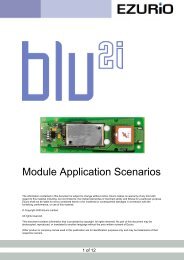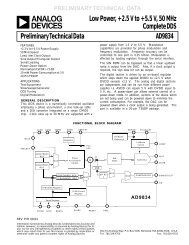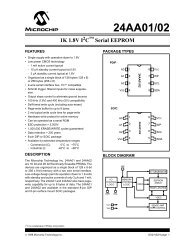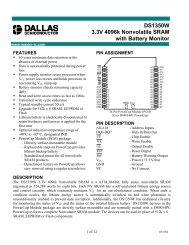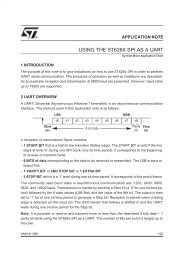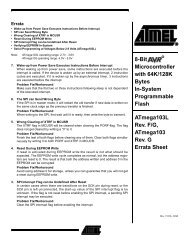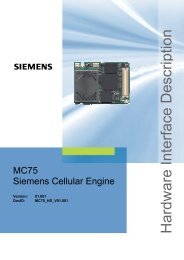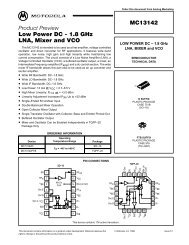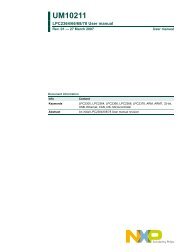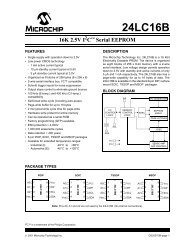Hardware Interface Description - Standard ICs
Hardware Interface Description - Standard ICs
Hardware Interface Description - Standard ICs
You also want an ePaper? Increase the reach of your titles
YUMPU automatically turns print PDFs into web optimized ePapers that Google loves.
BISM2 Bluetooth Version 2.0 Serial Module1. General <strong>Description</strong>Ezurio’s BISM2 Bluetooth Serial Module is a fully integrated and qualified Class 1 Bluetooth solutiondesigned for lowest cost of integration and ownership for designers wishing to incorporate Bluetoothfunctionality into their products. The module is qualified to Bluetooth Version 2.0.The BISM2 Module is based on Cambridge Silicon Radio’s BlueCore 04 chipset. The module containall of the hardware and firmware for a complete Bluetooth solution, requiring no further components.The Module has an integrated, high performance antenna which is matched with the Bluetooth RF andbaseband circuitry. The firmware integrated into the BC04 chipset implement the higher layerBluetooth protocol stack, up to and including the Generic Access Profile (GAP), Service DiscoveryProfile (SDAP), Serial Port Profile (SPP), Dial Up Networking Profile (DUN), Headset Profile (HSP),Hands Free Profile (HFP), File Transfer Profile (FTP) and Audio Gateway. A virtual processor is usedwithin the BC04 to implement an AT command processor. This interfaces to the host system over astraight forward serial port using an extensive range of AT commands. The AT command set abstractsthe Bluetooth protocol from the host application, saving many months of programming andintegration time. It provides extremely short integration times for data oriented cable replacementand voice applications. A low cost development system is available for fast product evaluation anddevelopment.An alternative version of firmware is available that provides programming support for multi-pointapplications.The Module can be configured so that it can be attached to a ‘dumb’ terminal or attached to a PC orPDA for cable replacement applications.In addition to the Bluetooth functionality, The BISM2 Module provides access to 8 General I/O linesand 2 analogue input lines. These can be configured to provide connection to simple devices such asswitches or LEDs without requiring any external processing. Both the GPIO and ADC lines can beaccessed either via the wired host UART connection, or remotely over the Bluetooth link.The BISM2 module is supplied in a small form factor pcb (22.0mm x 34.0mm x 7.6mm), thatconnects to a main pcb using a 40 way Hirose connector. The module includes a high sensitivity,high gain antenna which provides excellent range. Typical open field performance provides ranges ofover 250 metres at transmit powers of only 4mW.Support is provided for low power modes that make the BISM2 particularly applicable to batterypowered installations.The BISM2 module is Lead-free and is RoHS compliant and supports an industrial temperature rangeof -40°C to +85°C.1.1 Applications• POS Equipment• Medical Equipment• Telematics• Voice Applications• Industrial Automation• Automotive and Marine ApplicationsBluetooth is a trademark owned by Bluetooth SIG, Inc., USA, and is licensed to Ezurio Ltdwww.ezurio.com 1© Ezurio Ltd 2005
2. FeaturesFeatureBluetooth Transmission Class 1ImplementationFully Bluetooth pre-qualified Bluetooth 2.0RangeFrequencyMax Transmit PowerMin Transmit PowerReceive SensitivityAntenna GainData Transfer rateSerial <strong>Interface</strong>Serial parametersPhysical sizeCurrent consumptionLow power sniff modeTemperature Range250 metres typical (free space)2.400 – 2.485 GHz+6dBm+0dBmBetter than -90dB+2dBiUp to 300KbpsRS-232 bi-directional for commands and data using AT commandsDefault 9600,n,8,1 - Configurable from 1,200bps to 961,200 bps.Support for DTR, DSR, DCD, RI, RTS, CTS22.0 x 34.0 x 7.6 mm, 8gLess than 36mA during data transfer in standard power mode. Lowerpowers are attainable with a configurable low power mode.2.5mA typSupply Voltage 3.3V – 7.0VBrown-out<strong>Interface</strong> LevelsAudioProfilesMultipointField upgradeableProtocolsGPIOLead freeNormal operation: -40°C to +85°CIntegrated brown out detection3.3V TTLAudio can be transferred over SCO channels through the PCM interfaceat 64kbps. PCM can be configured as master or slave.Server - SPP (Full), DUN, Audio Gateway, Headset, HandsfreeClient - All RFCOMM based profilesMax 7 slavesOver UARTSingle point firmware is controlled and configured using ATCommands, multipoint firmware uses a simple packet based protocoland requires a host to enable the module to function effectively.Single point only allows a point to point connection where asmultipoint allows more than one simultaneous connection.8 x digital2 x analogue (8 bit resolution)Lead-free and RoHS compliantwww.ezurio.com 2© Ezurio Ltd 2005
3. Functional Block Diagram* GPIO lines are utilised for DTR and an LED, but can be re-assigned3.1 Connection DiagramThe Module is equipped with a 40-pin 0.5mm pitch board-to-board connector that connects to theapplication platform.www.ezurio.com 3© Ezurio Ltd 2005
3.2 Pin <strong>Description</strong>sThe Hirose DF12C board-to-board connector on the module is a 40-pin double-row receptacle.The table below defines the pin functions. Note that this pin-out is as viewed from the underside ofthe Module.PinNo.Signal <strong>Description</strong> PinNo.Signal<strong>Description</strong>1 Analogue 0 1.8v Max 2 GPIO1 I/O for Host.3 Analogue 1 1.8v Max 4 GPIO2 I/O for Host5 SPI_MISO SPI bus serial O/P 6 UART_RI ‘Ring’ Input or Output7 SPI_CSB SPI bus chip select I/P 8 UART_DCD Input or Output9 SPI_CLK SPI bus clock I/P 10 UART_DSR Input11 GND 12 GPIO3/UART_DTR I/O for Host13 RESET Reset I/P ** 14 GPIO4 I/O for Host15 GND 16 GPIO5 I/O for Host17 SPI_MOSI SPI bus serial I/P 18 GND19 UART_CTS Clear to Send I/P 20 PCM_CLK PCM Clock I/P21 UART_TX Transmit Data O/P 22 PCM_IN PCM Data I/P23 UART_RTS Request to Send O/P 24 PCM_SYNC PCM Sync I/P25 UART_RX Receive Data I/P 26 PCM_OUT PCM Data O/P27 VCC_3V3 3.3V Output (Note 3) 28 N/C29 VCC_5V 3.6V < VIN < 6.0V 30 GND31 N/C 32 USB / RESERVED Do not connect33 GPIO6 I/O for Host 34 USB / RESERVED Do not connect35 GPIO7 I/O for Host 36 GND37 GPIO8 I/O for Host 38 GND39 RESERVED DO NOT CONNECT 40 N/CNotes:**The reset pin operation differs from previous BISM Serial Modules, as a brown-out detector is nowincorporated within the module. Customers migrating from previous modules should check theirimplementation.UART_RX, UART_TX, UART_CTS, UART_RTS, UART_RI, UART_DCD and UART_DSR are all 3.3v levellogic. For example, when RX and TX are idle they will be sitting at 3.3V. Conversely for handshakingpins CTS, RTS, RI, DCD, DSR a 0v is treated as an assertion.Pin 6 (UART_RI) is active low. It is normally 3.3v. When a remote device initiates a connection, thispin goes low. This means that when this pin is converted to RS232 voltage levels it will have thecorrect voltage level for assertion.Pin 8 (UART_DCD) is active low. It is normally 3.3v. When a connection is live this pin is low. Thismeans that when this pin is converted to RS232 voltage levels it will have the correct voltage level forassertion.Pin 10 (UART_DSR) is an input, with active low logic. It should be connected to the DTR output of thehost. When the BISM2 Module is in high speed mode (See definition for S Register 507), this pinwww.ezurio.com 4© Ezurio Ltd 2005
should be asserted by the host to ensure that the connection is maintained. A deassertion is taken tomean that the connection should be dropped, or an online command mode is being requested.The GPIO pins can be accessed using S Registers 621 to 628. GPIO4 is connected to an LED on themodule. If these I/O pins are set for input, then the LED will be driven by the host and appropriatedrive current requirements must be satisfied. A Logic 1 switches on the LED.GPIO3 is also used for DTR output (active low). See S Register 552.Analogue 0 and 1 should not exceed 1.8v and S Registers 7xx are used to access them.3.3 Electrical Specifications3.3.1 Absolute Maximum ratingsAbsolute maximum ratings for supply voltage and voltages on digital and analog pins of the Moduleare listed below; exceeding these values will cause permanent damage.Parameter Min Max UnitPeak current of power supply 0 100 mAVoltage at digital pins -0.3 3.7 VVoltage at POWER pin 3.3 7 V3.3.23.3.3 Recommended Operating Parameters3.3.3.1 Power SupplySignal Name Pin No I/O Signal level CommentsVcc 29 I 3.3V to 7.0V I typ = 50mAGND 11, 15, 18,30, 36, 386 Ground terminals to be attachedin parallelVCC_1V8 39 O 1.8V typical For monitoring only. No currentsourceVCC_3V3 27 O 3.3V typical For monitoring only. No currentsource3.3.3.2 RS-232 <strong>Interface</strong>Signal Name Pin No I/O Signal level CommentsUART_TX 21 O V OL max=0.2VV OH min=2.8VUART_RX 25 I V IL max=0.8VV IH min=2.10VV IH max=3.7VUART_CTS 19 I V IL max=0.8VV IH min=2.10VV IH max=3.7VUART_RTS 23 O V OL max=0.2Vwww.ezurio.com 5© Ezurio Ltd 2005
V OH min=2.8VUART_DSR 10 I V IL max=0.8VV IH min=2.10VV IH max=3.7VUART_DTR 12 O V OL max=0.2VV OH min=2.8VUART_RI 6 I or O O/P : V OL max=0.2VV OH min=2.8VI/P : V IL max=0.8VV IH min=2.10VV IH max=3.7VUART_DCD 8 I or O O/P : V OL max=0.2VV OH min=2.8VI/P : V IL max=0.8VV IH min=2.10VV IH max=3.7VShared with GPIO3Direction may be programmed.Direction may be programmed.3.3.3.3 SPI BusSignal Name Pin No I/O Signal level CommentsSPI_MOSI 17 I V IL max=0.8VV IH min=2.10VV IH max=3.7VUsed to reprogram FlashSPI_MISO 5 O V OL max=0.2VV OH min=2.8VSPI_CSB 7 I V IL max=0.8VV IH min=2.10VV IH max=3.7VSPI_CLK 9 I V IL max=0.8VV IH min=2.10VV IH max=3.7V3.3.3.4 PCM <strong>Interface</strong>Signal Name Pin No I/O Signal level CommentsPCM_CLK 20 I or O O/P : V OL max=0.2VV OH min=2.8VI/P : V IL max=0.8VV IH min=2.10VV IH max=3.7VIf unused keep pins openPCM_IN 22 I V IL max=0.8VV IH min=2.10Vwww.ezurio.com 6© Ezurio Ltd 2005
V IH max=3.7VPCM_SYNC 24 I or O O/P : V OL max=0.2VV OH min=2.8VI/P : V IL max=0.8VV IH min=2.10VV IH max=3.7VPCM_OUT 26 O V OL max=0.2VV OH min=2.8V3.3.3.5 General Purpose I/O and ADCSignal Name Pin No I/O Signal level CommentsGPIO 1 - 5 2,4,12,14,16I or OO/P : V OL max=0.2VV OH min=2.8VI/P : V IL max=0.8VV IH min=2.10VV IH max=3.7VAIO_0, AIO_1 1, 3 I/O Vout max=VDD_PIO-.3Vout min=VDD_PIO3.3.3.6 MiscellaneousFunction Signal Name Pin No I/O Signal level CommentsReserved USB D- 32 I V IL max =0.3vdd_padsV IH min =0.7cdd_padsReserved USB D+ 34 I V IL max =0.3vdd_padsV IH min =0.7cdd_padsNormally inactive.Pull to GNDthrough 10KNormally inactive.Pull to GNDthrough 10KReset RESET 13 I VDD fallingthreshold=1.5V typVDD risingthreshold=1.6V typwww.ezurio.com 7© Ezurio Ltd 2005
4. I/O Characteristics4.1 Power ConsumptionThe current drain from the Vcc power input line is dependent on various factors. The three mostsignificant factors are the voltage level at Vcc, UART Baudrate and the operating mode.The hardware specification for the Module allows for a voltage range of 3.3 to 7.0 at Vcc. Tests haveshown that there is no significant difference in current draw when Vcc is 5 or 6V. Therefore the datapresented below, pertains to Vcc levels of 3.6 and 5v only. Tests have shown that where power drainis an issue, it is best to keep Vcc at the lower end of the range.The UART baudrate has a bearing on power drain because as is normal for digital electronics, thepower requirements increase linearly with increasing clocking frequencies. Hence higher baudratesresult in a higher current drain.Finally with regards to operating mode the significant modes are; idle, waiting for a connection,inquiring, initiating a connection, sniff and connected. With connected mode, it is also relevant todifferentiate between no data being transferred and when data is being transferred at the maximumrate possible. The AT command Set document describes how to configure the Module for optimalpower performance.4.1.1 Typical Current Consumption in mABaudrate9,600 38,400 115,200 460,800Idle Mode, S512=13.6v 1.60 1.80 1.96 3.005.0v 2.00 2.10 2.30 3.40Wait for Connection Or Discoverable Mode,AT+BTPS508=S510=640, S509=S511=320Wait for Connection Or Discoverable Mode,AT+BTPS508=S510=1000, S509=S511=11*Inquiring Mode, AT+BTI3.6v 59.00 59.00 59.00 59.005.0v 65.00 65.00 65.00 65.003.6v 2.75 2.94 3.10 4.125.0v 3.26 3.36 3.55 4.633.6v 50.00 50.00 50.00 50.005.0v 54.00 54.00 54.00 54.00Connecting Mode (ATDxxx)3.6v 50.00 50.00 50.00 50.005.0v 54.00 54.00 54.00 54.00Connected Mode (No Data Transfer)3.6v 6.00 6.10 6.40 7.205.0v 7.20 7.20 7.40 8.20Connected Mode (Max Data Transfer)3.6v 21.50 22.50 24.50 32.505.0v 24.50 26.00 28.00 36.00* Note: calculated figureswww.ezurio.com 8© Ezurio Ltd 2005
5. DC Characteristics5.1 RF Performance5.1.1 Transmit PowerConducted Transmit Power min: 1.0mW (0dBm) max: 4mW (6dBm)Antenna Gain+2dBi typ.Effective Transmit Power min: 0dBm max Max: +6dBm5.1.2 Receive SensitivityReceive SensitivityAntenna GainEffective Receive Sensitivity-86dBm (at 25°C)+2dBi typ-88dBm (at 25°C)5.1.3 RF Performance DataReceive Sensitivity0-40 deg -20 deg 0 deg 20 deg 40 deg 60 deg 80 deg 100 deg-10-20-30Attenuation Setting dBm-40-50-60-70-80-90-100Temperature Deg. C.NOTE: Measured as attenuation requiredto achieve better than 0.1% BER5.2 RangeSee the Data Transfer Rate vs distance graph below. The data throughput of the Module is limited to280Kbps by the parsing of the data being transferred through the AT command processor. The graphbelow shows the typical data thoughput with and without the AT command processing. Distances aremeasured in free space between 2 Modules.www.ezurio.com 9© Ezurio Ltd 2005
Data Transfer Rate / Distance800700600Data Transfer Rate (kbps)500400300RF data rateSerial port data rate200100010m 50m 100m 150m 200m 250m 300mDistance (meters)5.3 Temperature PerformanceData Transmit Rate with Temperature and Attenuation800700Data Transmission Rate kbs600500400300200-40 deg-20 deg0 deg20 deg40 deg60 deg80 deg100 deg1000-60dBm -65dBm -70dBm -75dBm -80dBm -85dBm -90dBmdBm attenuationwww.ezurio.com 10© Ezurio Ltd 2005
6. Functional <strong>Description</strong>The BISM2 Bluetooth module is a self-contained Bluetooth product and requires only power toimplement full Bluetooth communication. The integrated, high performance antenna together with theRF and Base-band circuitry provides the Bluetooth wireless link and the UART interface provides aconnection to the host system.The variety of interfaces and the AT command set allow the BISM2 module to be used for a widenumber of short range wireless applications, from simple cable replacement to complex multipointapplications, where multiple radio links are active at the same time.The complexity and flexibility of configuration are made simple for the design engineer by theintegration of a extremely comprehensive set of AT commands, supplemented with a range of “S”registers which are used for non-volatile storage of system parameters. These are fully documentedin the “Blu2i AT Command Reference Manual”.To provide the widest scope for integration a range of different physical host interfaces are provided:6.1 <strong>Interface</strong>s6.1.1 UART interfaceUART_TX, UART_RX, UART_RTS and UART_CTS form a conventional asynchronous serial data portwith handshaking. The interface is designed to operate correctly when connected to other UARTdevices such as the 16550A. The signalling levels are nominal 0V and 3.3V and are inverted withrespect to the signalling on an RS232 cable. The interface is programmable over a variety of bitrates; no, even or odd parity; stop bit and hardware flow control. The default condition on power-upis pre-assigned in the external Flash. Two-way hardware flow control is implemented by UART_RTSand UART_CTS. UART_RTS is an output and is active low. UART_CTS is an input and is active low.These signals operate according to normal industry convention.By writing different values to the relevant S register the UART_RI can be continuously polled to detectincoming communication. The UART_RI signal serves to indicate incoming calls.UART_DSR is an active low input. It should be connected to DTR output of the host. When the moduleis running in high speed mode (See definition for S Reg 507), this pin should be asserted by the hostto ensure connection is maintained. A de-assertion is taken to mean that the connection should bedropped, or an online command mode is being requested.The module communicates with the customer application using the following signals:RS-232Port /TXD @ application sends data to the module’s UART_RX signal linePort /RXD @ application receives data from the module’s UART_TX signal lineSerial ModuleApplicationUART_TX/RXDUART_RX/TXDUART_CTS/RTSUART <strong>Interface</strong>UART_RTSUART_DSRUART_DTRUART_RIUART_DCD/CTS/DTR/DSR/RING/DCDRS232 <strong>Interface</strong>Figure 6.1 : UART interfaceswww.ezurio.com 11© Ezurio Ltd 2005
6.1.2 SPI busThe Module is a slave device that uses terminals SPI_MOSI, SPI_MISO, SPI_CLK and SPI_CSB. Thisinterface is used for program firmware update.Note: The designer should be aware that no security protection is built into the hardware or firmwareassociated with this port, so the terminals should not be permanently connected in a PC application.6.1.3 GPIO PortEight lines of programmable bi-directional input/outputs (I/O) are provided that can be accessedeither via the UART port, or Over The Air from a second Bluetooth unit. These can be used as datainputs or to control external equipment. By using these in OTA mode, a BISM21 module can be usedfor control and data acquisition without the need for any additional host processor.Each of the GPIO[1:8] ports can be independently configured to be either an Input or Output. Aselection of ports can be accessed synchronously.GPIO 1 and 2 can be configured as event counters.The ports are powered from V CC . The mode of these lines can be configured and the lines areaccessed via S Registers 621 to 625.Low latency I/O can be accessed by using Ezurio’s I/O via an enhanced inquiry process.6.1.4 PCM CODEC <strong>Interface</strong>PCM_OUT, PCM_IN, PCM_CLK and PCM_SYNC carry up to three bi-directional channels of voice data,each at 8ksamples/s. The format of the PCM samples can be 8-bit A-law, 8-bit µ-law, 13-bit linear or16-bit linear. The PCM_CLK and PCM_SYNC terminals can be configured as inputs or outputs,depending on whether the module is the Master or Slave of the PCM interface.The Module is compatible with the Motorola SSI TM interface and interfaces directly to PCM audiodevices including the following:6.1.4.1 Compatible Codec Chips• Qualcomm MSM 3000 series and MSM 5000 series CDMA baseband devices• OKI MSM7705 four channel A-law and µ-law CODEC• Motorola MC145481 8-bit A-law and µ-law CODEC• Motorola MC145483 13-bit linear CODEC6.1.5 ADCThe BISM2 provides access to two 8-bit ADCs. These provide an input range of 0mV to 1,800mV,which can be read using the S registers 701 and 702.Suitable external scaling and over-voltage protection should be incorporated in your design. Themodule provides 5 samples per second at the UART with a baud rate of 115200 or above.www.ezurio.com 12© Ezurio Ltd 2005
7. Integrated Firmware7.1 GeneralThe BISM2 has been designed to provide the fastest route to market for designers who wish to useBluetooth to wirelessly enable their products. To achieve this Ezurio has implemented a wide rangingset of AT commands that control all of the standard Bluetooth tasks. These remove the complexity ofBluetooth from the design engineer and allow the wireless link to be controlled by means of a simpleset of commands.For applications where multiple concurrent live connections need to be maintained a variant offirmware is available which is specifically targeted at multipoint operation.For both applications a comprehensive range of windows based software and is available to speed upthe design process. A low cost development kit is also available that can be used for prototyping bothcable replacement and multipoint applications.7.2 ProfilesBluetooth has been designed to accommodate a very wide range of wireless applications. To enablethese different applications the Bluetooth SIG (Special Interest Group) has defined a series ofdifferent profiles that define the way in which Bluetooth devices communicate with each other andperform basic functions. These provide a base line of interoperability for specific applicationscenarios, upon which more complex user applications can be developed.There are over 30 different profiles, many of which have been developed for specific applications.The BISM2 firmware is provided with support for the profiles that are most commonly required forcable replacement applications.The current profiles support includes:• GAP Generic Access Profile. The base connection profile upon which others are based.• SDP Service Discovery Profile. The profile to find other Bluetooth devices and the servicesthey support.• SPP Serial Port Profile. Emulation of a serial cable for cable replacement applications.• DUN Dial Up Networking. Profile support for connection to an external PSTN, GSM, GPRSor VPN connection.• Audio Gateway. The base element for Headset and Handsfree profile. A portion of theseprofiles must be implemented within the host system.• HSP Headset Profile. Supports early implementations of headsets. Now largely replacedby the:• HFP Hands-free profile, which provide more control over the headset operation.• FTP File Transfer Profile.For other profile support, please contact Ezurio Ltd at blu2i@ezurio.com7.3 AT OverviewThe AT command set is well known by engineers and was developed to aid the integration of PSTNmodems. It provides simple high level commands for complex functions that can easily beincorporated into programs or used within programming scripts.Ezurio has used this familiar concept and extended it to Bluetooth to simplify the integration ofBluetooth for product designers. Rather than having to understand the many stages of setting up aBluetooth connection or function, a single AT command is all that is required.For example to connect to a Bluetooth device with an address 00809844EA13, all that is needed is tosend the stringwww.ezurio.com 13© Ezurio Ltd 2005
ATD00809844EA13to the UART of the BISM2 module. The module will attempt to make a connection and return connect00809844ea13,1101) or (NO CARRIER), depending on whether the connection was successful.The scope of the AT command set developed by Ezurio is such that most Bluetooth functionality canbe covered, greatly reducing development time.To provide additional functionality a range of “S” registers has been implemented. These allowprogram settings to be stored to control the BISM2 function and also give access to configuring andreading ports and status registers within the BISM2.Full details o f the AT command set are provided in the Blu2i AT Command Reference Manual.7.3.1AT features at a glance7.3 .1 .1 General• Configure two modules to automatically connect and transfer data, audio or a combination ofdata and audio when both devices are powered.• Automatically re-connect devices when a connection is dropped.• Remotely access the AT parser of the remote unit from a master device to perform Over TheAir (OTA) configuration.• Configure the module to enter a state on power up and after a period of time change toanother state automatically• Read and write to GPIO lines• Read the ADC channels• Ge t fast GPIO status through an inquiry response (patent pending)7.3 .1.2Audio• Set up audio connections• En able / disable Auto Answer for incoming connections7.3 .1.3UART• Change the baud rate from 1200 to 961,200 baud.• Use the DSR line to drop connections• Configure as DTE or DCE• Change escape sequence character• Change the number of Stop bits and Parity• Enableor disable echoes7.3 .1.4Security• Enable Authentication by requiring a PIN code for incoming AND / OR outgoing connections• Enable data to be encrypted over the air for incoming AND / OR outgoing connections. Themodule can be configured to be:non-connectable and non-discoverable,non-connectable but discoverable,connectable but non-discoverable,connectable and discoverable.• Automatically store Paired devices in a trusted device database in the flash memory7.3 .1.5Bluetooth• Set the module to be a master or slave• Make a Bluetooth connection to a specified devicewww.ezurio.com 14© Ezurio Ltd 2005
• Perform a full inquiry for other Bluetooth devices• Query a remote device to check if a service is offered• Fetch the friendly name of a remote device• Increase or decrease the delay before the master abandons a connection attempt• Change the device class code• Set the device’s friendly name• Change the Inquiry scan time• Change number of returned devices from an inquiry scan• Obtain the RSSI value for a connection7.3 .1.6Power Management• Decrease or increase the output power to suit your connection range• Configure the modules to work in Sniff and other low power modes.7.4 Multipoint FirmwareThe Module consists of the same hardware as that used for the single point ‘AT’ blu2i moduledescribed elsewhere. Whereas the latter only allows one-to-one connection, the module describedhere allows simultaneous connections to a minimum of 3 slaves, and depending on hardware build,up to 7 slaves. It also allows connections to multiple profiles to one or more slaves. Hence thisdocument adopts a concept of channels instead of slave connections.The term ‘host’ in this document is taken to mean any entity which is a source of commandmessages, sink for response/event messages and both source and sink for multiplexed data packets.A module with multipoint firmware can connect or accept connections to / from a number of moduleswith AT firmware simultaneously7.5 OTA (Over the Air) ConfigurationWhen the BISM2 has its remote AT parser enabled, its settings can be remotely controlled by amaster unit. This places the slave unit’s AT parser in remote mode providing over the airconfiguration. This mode is of use for remote sensor applications, where no host processor isrequired to control the slave Bluetooth unit.7.6 Boot modesThe module has the capability of booting into 1 of 8 modes. These will be supported in futurereleases of firmware and selected via an S Register.Boot Mode 1 is default and gives functionality equivalent to the BISM1 module.These modes will specify different PSKEY settings to allow for different basic operation. PleasecontactEzurio for further information.www.ezurio.com 15© Ezurio Ltd 2005
8. Low Power ModesThe current drain from the Vcc power input line is dependent on various factors. The three mostsignificant factors are the voltage level at Vcc, UART baud rate and the operating mode.The hardware specification for the blu2i module allows for a voltage range of 3.6 to 6.0v at Vcc. Testshave shown that there is no significant difference in current draw when Vcc is 5 or 6V. Therefore thedata presented below, pertains to Vcc levels of 3.6 and 5v only. Tests have shown that where powerdrain is an issue, it is best to keep Vcc at the lower end of the range.The UART baud rate has a bearing on power drain because as is normal for digital electronics, thepower requirements increase linearly with increasing clocking frequencies. Hence higher baud ratesresult in a higher current drain.Finally with regards to operating mode the significant modes are; idle, waiting for a connection,inquiring, initiating a connection and connected. With connected mode, it is also relevant todifferentiate between no data being transferred and when data is being transferred at the maximumrate possible.The operating mode can best be described by stating the AT commands required to enter that mode.In addition, there are certain S Registers which have a direct impact on power consumption, whichare described next.The blu2i Module has a single LED which can be configured to display connection status. Tests haveshown that this LED can consume up to 5.3mA which is more than double the current draw when inIdle mode. Therefore S Registers 533 can be used to completely disable this indicator.S Registers 508 to 511, which specify the page and inquiry scan intervals and windows, can be usedto adjust the average current drain when in discoverable and or connectable modes. Registers 508and 509 specify the interval and window for page scans and registers 510 and 511 specify theinterval and window for inquiry scans. Register pairs 508/509 and 510/511 describe duty cycles whenthe blu2i module goes into scan modes. It is while scanning that the highest current draw occurs. Theaverage current draw is determined by simple arithmetic using the values stored in the 508/509 and510/511 register pairs.Typical current consumption is given in Section 4.1.The current drain while waiting for a connection or discoverable mode is about 30 times higher thanin idle mode. This is when the page/inquiry scan duty cycle is 100%. These modes give the quickestresponse to a page or inquiry request from a remote peer.It is possible to reduce the duty cycle down to as low as 0.5% at the expense of response time. Theresponse time can be specified via S Registers 508 and 510 for page and inquiry respectively, wherethe worst case response time can be as high as 2.5 seconds. Then the duty cycle can be varied bychanging the value of S Registers 509 and 511 appropriately.For example, if S Register 508 and 510 are both set to 1000ms and S Register 509 and 511 are bothset to 11ms then the duty cycle is reduced to 1%, this means that average current drain at 5.0v willbe 2% of 65mA plus the normal idle mode current, that is, it is as low as 2.75mA. However, in thiscase, it can take up to 1 second to establish a connection.The connected state current consumption while a master or slave can be considerably reduced byenabling Sniff mode, described in detail in the next section.mACurrent per LED (when fitted)3.6V 3.205.0V 5.30www.ezurio.com 16© Ezurio Ltd 2005
8.1 Low Power Modes using SniffBluetooth connections are master/slave in nature. A master sends packets and a slave has toacknowledge that packet in the next timeslot. Timeslots in Bluetooth are 625 microseconds wide. Thisimplies that a master will always know when packets will be sent and received, which further meansit is able to optimise power usage by switching on power hungry circuitry only when needed.A slave on the other hand does NOT have prior knowledge of when a packet will be received and hasto assume that a packet will be received from a master on every receive slot. This means that it hasto leave its receiving circuitry on for most of the receive slot duration. The result of this is high powerconsumption as illustrated in the power table above, where a slave with no data transmission stillconsumes around 31mA whereas a master consumes only 6mA.This problem was identified very early in the evolution of Bluetooth (especially since headsets spendall their time as a slave in a Bluetooth connection) and it was solved by having a mode called Sniff,with appropriate lower layer negotiating protocol.Sniff mode during connection is basically an agreement between the slave and its master that datapackets will only be exchanged for N timeslots every M slots. The slave can then assume that it willnever be contacted during N-M slots, and so can switch its power hungry circuitry off. Thespecification goes further by also specifying a third parameter called ‘timeout’ (T) which specifies‘extra’ timeslots that the slave will agree to listen for after receiving a valid data packet. Put anotherway, if a data packet is received by the slave, then it knows that it MUST carry on listening for atleast T more slots. If within that T slot time period another data packet is received, then the timer isrestarted. This mechanism ensures low power consumption when there is no data transfer – at theexpense of latency. When there is a lot of data to be transferred, it acts as if sniff mode were notenabled.It is stated above that during sniff mode, a slave listens for N slots every M slots. The Bluetoothspecification states that a master can have up to 7 slaves attached to it with all slaves havingrequested varying sniff parameters. It may therefore be impossible to guarantee that each slave getsthe M parameter it requested. In light of this, the protocol for enabling sniff mode specifies that arequesting peer specify the M parameter as a minimum and maximum value. This will allow themaster to interleave the sniff modes for all slaves attached.For this reason, the sniff parameters are specified in the BISM2 module via four S registers. SRegister 561 is used to specify ‘N’, S Register 562 is used to specify ‘T’ and S Registers 563/564 areused to specify minimum ‘M’ and maximum ‘M’ respectively. Although the specification defines theseparameters in terms of timeslots, the S register values have to be specified in units of millisecondsand the firmware does the necessary translation to timeslots.High Power ConsumptionData ExchangeData ExchangeData Exchange ExhangeData ExchangeT SlotsT SlotsData ExchangeLow Power ConsumptionT SlotsT SlotsT SlotsN Slots N Slots N SlotsM Slots (Negotiated)M Slots (Negotiated)www.ezurio.com 17© Ezurio Ltd 2005
9. Application Examples9.1 RS232 Modem SignalsJust as a telephony modem has control and status lines, the blu2i Module also provides for 6 controland status lines as per the table below. The direction column is as seen from the module’s viewpoint.DirectionIN or OUTIN or OUTINOUTINOUTFunctionCI also known as RI (Ring Indicate)DCD (Data Carrier Detect)DSR (Data Set ready)DTR (Data Terminal Ready)CTS (Clear to Send)RTS (Request to Send)The first four lines are under program control. These use four of the GPIO pins and are mapped toI/O as per the table below. The last two are under control of the UART driver and their functionality isalways enabled.PIO Pin Direction Connector Pin Label Function0 IN/OUT GPIO1 General Purpose I/O1 IN/OUT GPIO2 General Purpose I/O2 IN/OUT UART_RI Input/Output from module3 IN/OUT UART_DCD Input/Output from module4 IN UART_DSR Input to Module5 IN/OUT GPIO3/UART_DTR General Purpose I/O (or DTR functionality)6 IN/OUT GPIO4/LED General Purpose I/O (LED)7 IN/OUT GPIO5 General Purpose I/ONotes:1. PIO4 (DSR) is used by the blu2i module to sense that the host is connected, and is intricatelylinked with connections. For outgoing calls, if this line is not asserted then an error is indicated.Similarly for AT+BTP and AT+BTG.While in a call, for appropriate modes, a de-assertion means fall into command state. If the deassertionexists for longer than the period specified in S Register 519 then the connection is droppedas if an ATH command was received.2. PIO2 (RI), is normally de-asserted. When an incoming connection is detected it will beasserted, until the connection is either answered or rejected using ATA and ATH respectively. See SRegisters 552 & 553 for more details3. PIO3 (DCD) will be de-asserted when the device is in the unconnected state. Asserted when aconnection is active. See S Registers 552 and 553 for more details.4. PIO5 is either used as GPIO or driven as UART_DTR. When the unit is configured in pure hostmode, this pin is forced into UART_DTR and is asserted when there is a Bluetooth connection.GPIO Pins 1,2,3,4 and 5 are available for general purpose use.www.ezurio.com 18© Ezurio Ltd 2005
9.2 Modem signalling over BluetoothThe RFCOMM protocol used in Bluetooth for implementing the serial port profile allows for theexchange of four modem signals. This information is contained in a special transparent messagewhich contains bits identified as RTR, RTC, DV and IC which depending on the type of serial devicebeing emulated maps to DTR or DSR, RTS, DCD and RI respectively. In addition, this message alsoincludes the ability to convey a BREAK input from one end to the other.To allow for the greatest flexibility and variability in how the modem control signals are used out inthe real world, S Registers 551, 552 and 553 have been provided which allow for any of RTR,RTC,DVand IC to be mapped to any modem control/status line.BREAK signal on RX lineIf the host sends a break signal of duration greater than 100ms, then the blu2i module isconfigured to treat that as a signal to perform a hardware reset.This being the case it is not possible to convey a BREAK over Bluetooth to the peer device.ResetThe module can be reset by the host without the need of any I/O using a BREAK signal. Themodule has been configured to reset when the RX line detects a break condition for durationsgreater than 100 milliseconds.9.3 Pure Cable Replacement ModeThe module has the capability of being preset into a pure 5-wire data cable replacement mode. The 5wires being RX, TX, CTS, RTS and GND. This mode requires no changes to a host application sincethe Bluetooth connection is automatically set up on power up. If the connection is lost the BISM2module will constantly retry until the connection is reinstated.By implication, two devices are needed to replace a cable. One device is pre-configured to always bea master and the other, a slave.Assuming the Bluetooth address of the master to be and that of the slave to be, the master module is configured by sending it the following AT commands:AT&FATS512=1ATS504=1ATS507=2ATS530=2000AT&WAT+BTRThe ATS507=2 setting puts the device in DSR drop mode only. This means that when the deviceneeds to be reconfigured, deasserting the DSR line will ensure that the module responds quickly to ATcommands. This further means that in stand alone mode, the DSR input line MUST be asserted e.g.0V in TTL signal mode.The slave is configured by:AT&FATS512=4www.ezurio.com 19© Ezurio Ltd 2005
ATS0=-1AT&WAT+BTRWhere is optional. If it is not specified, then the slave unit will accept connections fromany device. If specified then only connections from the device specified will be accepted.If it is desired that the slave unit should not be discoverable (the master is by default notdiscoverable), then the configuration commands are:AT&FATS512=3ATS0=-1AT&WAT+BTRWhere is optional. If it is not specified, then the slave unit will accept connections fromany device. If specified then only connections from the device specified will be accepted.When the units are next power cycled, the slave unit will wait for the master to connect to it and themaster will continually look for the slave. If a connection attempt fails, the master will wait for 2seconds before reattempting a connection. This 2 second delay can be varied by issuing it an ATS530command with an appropriate value in the range 100ms to 15000ms.IMPORTANT NOTE: When S Register 507 = 0, the DSR input to the module MUST be asserted for theauto connection to succeed. When operating at TTL levels a 0V is seen as an assert state. Whenoperating at RS232 levels and voltage greater than 3V is seen as assert. It is usual to connect theDTR line of the host to the DSR line of this device.9.4 Audio Cable (voice)With a pair of these modules it is possible to replace a mono audio cable with two way traffic. That is,a setup where a microphone is connected to a speaker at the remote end and vice versa. So thismode effectively replaces two audio cables.Assuming the Bluetooth address of the master to be and that of the slave to be, the master module is configured by sending it the following AT commands:AT&FATS512=1ATS504=1ATS530=2000ATS532=1AT&WAT+BTRAnd the slave is configured by:AT&FATS512=4ATS0=-1AT&WAT+BTRwww.ezurio.com 20© Ezurio Ltd 2005
9.5 Modem Control and Status SignalsA serial port has DTR, DSR, RTS, CTS, DCD and RI control lines. RTS and CTS are locally controlled toprevent local buffer overflow.However the status of DTR, DRS, DCD and RI can be exchanged with the remote peer device. If forexample, the DTR/DSR lines are to be exchanged between the two peers to simulate the performanceof a physical cable, then it is possible to do so. Refer to the description for S Registers 551, 552 and553 for more details.www.ezurio.com 21© Ezurio Ltd 2005
10. Application Information10.1 Antenna PositionThe antenna used on the BISM2 Bluetooth module is designed to be largely immune from the effectsof proximity detuning. Normally, antennas operating at 2.4GHz are affected by their surroundings, sothat great care is needed in their placement and orientation.The BISM2 can be used in most locations and orientations and is only marginally affected by thepresence of a significant ground plane in close proximity.The antenna distribution is close to isotropic, which means that the orientation of mounting has onlya limited effect on the overall range. However the optimum range is achieved when the twoantennae are directly facing each otherThe module should not be located in a sealed metal enclosure, as this will act as a Faraday cage andprevent the radio signal from penetrating.10.2 Power Supply ConsiderationsThe power supply for the Module has to be a single voltage source of Vcc within the range of 3.3 V to6.0 V. It must be able to provide sufficient current in a transmit burst. This can rise to 65mA.The Module includes regulators to provide local 3.3V. This rail is accessible on connector J2 formonitoring purposes only. Under no circumstances should this pin be used to source current.Power (Vcc) can be provided via the board-to-board connector Pin 29 on J2.10.3 Power-On-Reset (Power Cycling and Brownconsiderations).OutThe Module is provided with an active low reset pin (Hirose 40way DF12C connector pin 13). Uponthe application of power, the Power On Reset circuit built into the Module will ensure that the unitstarts correctly. There is no need for an external power reset monitor.Note: This pin function differs from the previous version of the blu 2i module, where an externalbrownout circuit was recommended to drive this pin. As the brownout circuitry is now included withinthe module a true active low reset is now implemented. Customers migrating from a BISM1 to BISM2module should check their usage of this pin.10.4 Mounting the Module onto the application platformThere are many ways to properly install the Module in the host device. An efficient approach is tomount the PCB to a frame, plate, rack or chassis. Fasteners can be M1.8 or M2 screws plus suitablewashers, circuit board spacers, or customized screws, clamps, or brackets in 2.2mm diameter holes.Note that care should be taken to ensure the head of the fixing does not interfere with the circuit.Nylon fixings are recommended. In addition, the board-to-board connection can also be utilized toachieve better support.The antenna (Brown square component on top side of PCB) must not be influenced by any otherPCBs, components or by the housing of the host device. The proximity of the antenna to largemetallic objects can affect the range and performance of the system. Designers should carefullyconsider the location of the Module and the type of enclosure material that is used.To prevent mechanical damage, be careful not to force, bend or twist the Module. Be sure it ispositioned flat against the host device.www.ezurio.com 22© Ezurio Ltd 2005
11. Board to Board ConnectorThis chapter provides specifications for the 40-pin board-to-board connector which serves as physicalinterface to the host application. The receptacle assembled on the Module is Hirose type DF12C.Details are available at: http://www.hirose.co.jp/cat2002e/500/e53700036.pdf11.1 Stacking HeightMating headers from Hirose are available in different stacking heights, allowing the spacing betweenthe BISM2 and carrier pcb to be changed from 3.5mm to 5.0mm.Item Part number Stacking height HRS numberReceptacle onModuleDF12C-40DS-0.5V(81) 3.5 mm – 5 mm CL537-0007-7-Headers DF12 series DF12(3.5)-40DP-0.5V(81) 3.5 mm CL537-0032-4-**DF12(4.0)-40DP-0.5V(81) 4.0 mm CL537-0057-5-**DF12(5.0)-40DP-0.5V(81) 5.0 mm CL537-0157-0-**Notes: The headers listed above are without boss and metal fitting.11.2 Hirose Connector general specificationParameterSpecification (40 pin Board to Board connector)Number of Contacts 40Quantity delivered2000 Connectors per Tape & ReelVoltage50VCurrent Rating0.5A max per contactResistance0.05 Ohm per contactDielectric Withstanding Voltage 500V RMS minOperating Temperature-45°C...+125°CContact Materialphosphor bronze (surface: gold plated)InsulatorMaterial PA , beige naturalStacking height3.0 mm ; 3.5 mm ; 4.0 mm ; 5.0 mmInsertion force 21.8NWithdrawal force 1st10NWithdrawal force 50th10NMaximum connection cycles 50www.ezurio.com 23© Ezurio Ltd 2005
12. Qualification12.1 Bluetooth Qualification ProcessThe following safety precautions must be observed during all phases of the operation, usage, serviceor repair of any application incorporating this Module. Manufacturers of the RF equipment are advisedto convey the following safety information to users and operating personnel and to incorporate theseguidelines into all manuals supplied with the product. Failure to comply with these precautionsviolates safety standards of design, manufacture and intended use of the product. Ezurio assumes noliability for customer failure to comply with these precautions.12.2 Safety Information:Switch off the Bluetooth device before boarding an aircraft. Make sure it cannot be switched oninadvertently. The operation of wireless appliances in an aircraft is forbidden by many airlines toprevent interference with communications systems. Applications that could result in use on aircraftshould carry appropriate warnings.12.3 Qualifications12.3.1 RF approvalsThe Module is listed as a Bluetooth Product in terms of the Bluetooth SIG Program ReferenceDocument (PRD). This means that it can be integrated into end products without further testing orapproval listing. The manufacturer must state the Ezurio part number and product reference in hisliterature in order to meet the requirements of the Bluetooth and regulatory approvals.A list of the countries where the Module is approved will be provided by Ezurio as required. As aminimum the product is listed in Europe and USA. Ezurio assumes no liability for customer failure tocomply with national RF approvals.12.3.1.1 Radio.R&TTE EN 300 328-2 V1.1.1 (2000-07)EN 301 489-1 V1.3.1 (2001-09)12.3.1.2 EMC Emissions.FCC15B Class BEN55022 Class B12.3.1.3 EMC Immunity.EN55024 Class12.3.1.4 Environmental.EN301 489-1 V1.3.1 (2001-09)12.3.1.5 MedicalEN60601-1-212.3.1.6 AutomotiveEmission test to 95/54/ECwww.ezurio.com 24© Ezurio Ltd 2005
12.4 Safety and Regulatory Statements12.4.1 Europe – EU Declaration of ConformityDECLARATION OF CONFORMITYIn accordance with Annex IV of the EU directive 1999/5/ECNotified Body consulted:Phoenix Test-LabID-Number of Notified Body: 0700declare under our responsibility that the blu2i Modulecomplies with the appropriate essential requirements of the Article 3 ofthe R&TTE and the other relevant provisions, when used for its intendedpurpose.Health and Safety requirements contained in Article 3 (1) a)EN 60 950: 1992 Safety of information technology equipment +Amendment A1:1993, Amendment A2:1993, Amendment A3:1995,Amendment A4:1997, Amendment A11:1997EN 50371: Generic standard to demonstrate the compliance of lowpowerelectronic and electrical apparatus with the basic restrictionsrelated to human exposure to electromagnetic fields (10 MHz - 300 GHz)– General publicProtection requirements with respect to electromagnetic compatibilityArt.3 (1) b)EN 301489-17 V1.1.1 (09-2000), Electromagnetic Compatibility andradio spectrum Matters (ERM); Electro Magnetic Compatibility (EMC)standard for radio equipment and services; Part 17: Specific conditionsfor wideband data HiperLAN equipmentMeans of the efficient use of the radio frequency spectrumEN 300328-2 V1.2.1 (11-2001), Radio Equipment and Systems (RES);Wideband transmission systems; Technical characteristics and testconditions for data transmission equipment operating in the 2,4 GHz ISMband and using spread spectrum modulation techniques. Part 2:Harmonized EN covering essential requirements under article 3(2) of theR&TTE directive.Ezurio Ltd tel: +44 (0)20 8938 1000Unit 2, 126 Colindale Avenue, Colindale fax: +44 (0)20 8905 8608 Registered in EnglandLondon NW9 5HD, United Kingdom www.ezurio.com No. 5178293www.ezurio.com 25© Ezurio Ltd 2005
12.4.2 FCC and Industry Canada StatementsThis device complies with part 15 of the FCC Rules. Operation is subject to the following twoconditions: (1) This device may not cause harmful interference, and (2) this device must accept anyinterference received, including interference that may cause undesired operation.Changes or modifications not expressly approved by the party responsible for compliance could voidthe user's authority to operate the equipment.13. Environmental13.1 Operating temperaturesParameter Min Typ Max UnitOperating temp (standard product) -40 25 +85 °C13.2 Storage temperatureParameter Min Max UnitStorage temp -40 +125 °C13.3 ReliabilityParameter Test CommentThermal Shock 200 cycles -40ºC /+85ºC 30 min 1 cycle/hourVibrationContinuous operation at 60 Hz,2mm stroke15g max sine wave, 12 hoursShock 50G 11ms Half Sine Wave 6 axis x 3 cycles each axisMoisture ResistanceHigh Temp StorageLow Temp StorageHigh Temp/HumidityOperation85ºC, 360 hours-40ºC, 240 hours60ºC, 90%RH, 360 hoursThermal shock -40 to 60ºC in 30min 200 cycles with continuousoperationElectro Static DischargeEN55024:1998 & IEC61000-4-3Drop Test 75cm to concrete, 3 axis x 2cycles per cornerwww.ezurio.com 26© Ezurio Ltd 2005
14. Physical Dimensions14.1 Mechanical DimensionsAll dimensions in mm.14.2 LabellingThe label contains the Part number and the unique Bluetooth address of the module.www.ezurio.com 27© Ezurio Ltd 2005
14.3 Ordering InformationThe BISM2 is available with different variants of production firmware. Ordering information isprovided below:Part Number <strong>Description</strong> Firmware VersionTRBLU23-00200TRBLU23-002MPTRBLU23-002HCTRBLU23-00300TRBLU23-003MPTRBLU23-003HCBISM2 with integrated ceramic antenna andstandard AT firmwareBISM2 with integrated ceramic antenna andstandard Multipoint firmwareBISM2 with integrated ceramic antenna andstandard HCI firmwareBISM2 with SMA jack and standard ATfirmwareBISM2 with SMA jack and standard MultipointfirmwareBISM2 with SMA jack and standard HCIfirmwareVersion 4.9.0Version 1.4.5.0Version 4.9.0Version 4.9.0Version 1.4.5.0Version 4.9.015. Related Documents• blu2i AT Command Set Version 2.7.0 Reference Manual• blu2i Firmware Release Notes Version 2.7.0• blu2i Multipoint Firmware Reference Manual• BISM Bluetooth Serial Module - Quick Start Guide• BISM Bluetooth Serial Module - FAQ• Blu2i Application Scenarios• BISM Developer’s Kit User Guide• Bluetooth Core 2.0 Specification – www.bluetooth.org16. Datasheet Revision HistoryVersion Date Changes0.91 10 th March 2005 Initial Draft for customer release.1.0 16 th March First customer releaseLED information addedReset Pin note indicating change from BISM1 added.www.ezurio.com 28© Ezurio Ltd 2005
17. DisclaimersEZURIO’S BLUETOOTH PRODUCTS ARE NOT AUTHORISED FOR USE AS CRITICAL COMPONENTS INLIFE SUPPORT DEVICES OR SYSTEMS WITHOUT THE EXPRESS WRITTEN APPROVAL OF THEMANAGING DIRECTOR OF EZURIO LTD.The definitions used herein are:a) Life support devices or systems are devices which (1) are intended for surgical implant into thebody, or (2) support or sustain life and whose failure to perform when properly used in accordancewith the instructions for use provided in the labelling can reasonably be expected to result in asignificant injury to the user.b) A critical component is any component of a life support device or system whose failure to performcan be reasonably expected to cause the failure of the life support device or system, or to affect itssafety or effectiveness.Ezurio does not assume responsibility for use of any of the circuitry described, no circuit patentlicenses are implied and Ezurio reserves the right at any time to change without notice said circuitryand specifications.17.1 Data Sheet StatusThis data sheet contains data from the Preliminary specification. Supplementary data will bepublished at a later date. Ezurio Ltd reserve the right to change the specification without notice inorder to improve the design and supply the best possible product.Please check with Ezurio Ltd for the most recent data before initiating or completing a design.17.2 WarrantyEzurio warrants that its products shall conform to Ezurio’s published specifications and remain freefrom defects in materials and workmanship under normal, proper and intended use for a period oftwo (2) years from date of purchase, provided that proof of purchase be furnished with any returnedequipment.If during the warranty period any component part of the equipment becomes defective by reason ofmaterial or workmanship, and Ezurio is immediately notified of such defect, Ezurio shall at its optionsupply a replacement part or request return of equipment, freight prepaid, to its designated facilityfor repair. In the event no trouble is found on products returned for repair, Ezurio reserves the rightto charge the customer its standard published repair charge.This warranty shall not apply to any products that have been subject to misuse, bending, twisting,neglect, alteration, improper installation, testing or unauthorized repair performed by anyone otherthan a Ezurio designated repair facility. Any non-warranty repairs or maintenance shall be at Ezurio’sstandard rates in effect at the time.This warranty is in lieu of all other warranties, whether expressed, implied, or statutory, including butnot limited to, implied warranties or merchantability and fitness for a particular purpose. In no eventshall Ezurio be liable, whether in contract, in part, or on any other basis, for any damage sustainedby its customers or any other person arising from or related to loss of use, failure or interruption inthe operation of any products, or delay in maintenance, or for incidental, consequential, in direct, orspecial damages or liabilities, or for loss of revenue, loss of business, or other financial loss arisingout of or in connection with the sale, lease, maintenance, use, performance, failure, or interruption ofthese products.www.ezurio.com 29© Ezurio Ltd 2005



